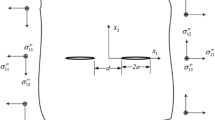Abstract
In this paper, the volume integral equation method (VIEM) is introduced for the analysis of multiple isotropic/anisotropic inclusions (or inhomogeneities) in an unbounded isotropic matrix. In order to introduce the VIEM as an accurate and efficient numerical method for the three-dimensional elastostatic inclusion (or inhomogeneity) problem, multiple isotropic/orthotropic spherical inclusions (or inhomogeneities) in an unbounded isotropic matrix under uniform remote tensile loading are investigated.
Similar content being viewed by others
References
J. D. Eshelby, The determination of the elastic field of an ellipsoidal inclusion, and related problems, Proceedings of the Royal Society A, 241 (1957) 376–396.
J. D. Eshelby, The force on an elastic singularity, Philosophical Transactions of the Royal Society A, 244 (1951) 87–112.
J. K. Lee and A. K. Mal, A volume integral equation technique for multiple scattering problems in elastodynamics, Applied Mathematics and Computation, 67 (1995) 135–159.
J. K. Lee and A. K. Mal, A volume integral equation technique for multiple inclusion and crack interaction problems, Journal of Applied Mechanics-Transactions of The ASME, 64 (1997) 23–31.
J. Lee and H. Kim, Volume integral equation n method for multiple circular and elliptical inclusion problems in antiplane elastostatics, Composites Part B: Engineering, 43 (2012) 1224–1243.
J. K. Lee, S. M. Oh and A. Mal, Calculation of interfacial stresses in composites containing elliptical inclusions of various types, European Journal of Mechanics, A/Solids, 44 (2014) 17–40.
J. K. Lee and M. G. Han, Volume integral equation method solution for spheroidal inclusion problem, Materials (MDPI), 14 (2021) Article ID 6996.
A. K. Mal and L. Knopoff, Elastic wave velocities in two component systems, Journal of the Institute of Mathematics and its Applications, 3 (1967) 376–387.
J. K. Lee and M. G. Han, Three-dimensional volume integral equation method for solving isotropic/anisotropic inhomogeneity problems, Mathematics (MDPI), 8 (2020) Article ID 1866.
J. Ma and Z. Nie, FEM-DDM with an efficient second-order transmission condition in both high-frequency and low-frequency applications, Progress in Electromagnetics Research B, 50 (2013) 253–271.
P. K. Banerjee, The Boundary Element Methods in Engineering, McGraw-Hill (1993).
Y.-H. Pao and V. Varatharajulu, Huygens’ principle, radiation conditions, and integral formulas for the scattering of elastic waves, The Journal of the Acoustical Society of America, 59 (1976) 1361–1369.
H. B. Li, G. M. Han and H. A. Mang, A new method for evaluating singular integrals in stress analysis of solids by the direct boundary element method, International Journal for Numerical Methods in Engineering, 21 (1985) 2071–2098.
J. Lee, Volume integral equation method (VIEM), Advances in Computers and Information in Engineering Research, J. G. Michopoulos, D. W. Rosen, C. J. Paredis and J. M. Vance (Eds.), ASME Press, New York, USA, 2 (2021) 79–138.
MSC.Software Corporation, PATRAN 2008 r2 Release Guide, Santa Ana, CA (2008).
H. R. Sadraie, S. L. Crouch and S. G. Mogilevskaya, A boundary spectral method for elastostatic problems with multiple spherical cavities and inclusions, Engineering Analysis with Boundary Elements, 31 (2007) 425–442.
H. Ma, Solutions of eshelby-type inclusion problems and a related homogenization method based on a simplified strain gradient elasticity theory, Ph.D. Thesis, Texas A&M University (2010).
C. Meng, W. Heltsley and D. D. Pollard, Evaluation of the Eshelby solution for the ellipsoidal inclusion and heterogeneity, Computers and Geosciences, 40 (2012) 40–48.
Y.-G. Lee, W.-N. Zou and E. Pan, Eshelby’s problem of polygonal inclusions with polynomial eigenstrains in an anisotropic magneto-electro-elastic full plane, Proceedings of the Royal Society A: Mathematical, Physical and Engineering Sciences, 471 (2015) 20140827.
W.-N. Zou and Q.-C. He, Eshelby’s problem of a spherical inclusion eccentrically embedded in a finite spherical body, Proceedings of the Royal Society A: Mathematical, Physical and Engineering Sciences, 473 (2017) 20160808.
Acknowledgments
This research was supported by the Basic Science Research Program through the National Research Foundation of Korea (NRF) funded by the Ministry of Science and ICT, Republic of Korea (Grant No. 2015-R1A2A2A01004531) and the 2021 Hongik University Research Fund. The authors would also like to acknowledge the support of the National Supercomputing Center with supercomputing resources including technical support (No. KSC-2021-CRE-0456).
Author information
Authors and Affiliations
Corresponding author
Additional information
Jungki Lee is a Professor at Hongik University (Sejong Campus). He received a Ph.D. in Mechanical Engineering from the University of California, Los Angeles, USA. His research interests are computational mechanics of solids, nondestructive evaluation, and composite materials. He has been developing the volume integral equation method (VIEM) with Professor Mal at UCLA.
Oh-Kyoung Kwon is a Principle Researcher at Korea Institute Science and Technology and Information. He received a Ph.D. in Computer Science and Engineering from KAIST, Daejeon, Korea. His current research interests are optimization and paralleization of HPC applications on a large-scale system. In particular, he has experiences in parallization of scientific applications including simulation of turbulent flows, weather forecasting and cosmological hydrodynamics on top of KISTI supercomputers.
Rights and permissions
About this article
Cite this article
Lee, J., Kwon, OK. Parallel volume integral equation method for three-dimensional multiple inclusion problems. J Mech Sci Technol 37, 239–259 (2023). https://doi.org/10.1007/s12206-022-1225-0
Received:
Revised:
Accepted:
Published:
Issue Date:
DOI: https://doi.org/10.1007/s12206-022-1225-0




